The effects of Cucumber Mosaic Virus and its 2a and 2b proteins on interactions of tomato plants with the Aphid Vectors Myzus persicae and Macrosiphum euphorbiae
Cucumber mosaic virus (CMV), a major tomato pathogen, is aphid-vectored in the non persistent manner. We investigated if CMV-induced volatile organic compounds (VOCs) or other virus-induced cues alter aphid–tomato interactions. Y-tube olfactometry showed that VOCs emitted by plants infected with CMV (strain Fny) attracted generalist (Myzus persicae) and Solanaceae specialist (Macrosiphum euphorbiae) aphids. Myzus persicae preferred settling on infected plants (3 days post-inoculation: dpi) at 1h post-release, but at 9 and 21 dpi, aphids preferentially settled on mock inoculated plants. Macrosiphum euphorbiae showed no strong preference for mock-inoculated versus infected plants at 3 dpi but settled preferentially on mock-inoculated plants at 9 and 21 dpi. In darkness aphids showed no settling or migration bias towards either mock-inoculated or infected plants. However, tomato VOC blends differed in light and darkness, suggesting aphids respond to a complex mix of olfactory, visual, and other cues influenced by infection. The LS-CMV strain induced no changes in aphid–plant interactions. Experiments using interstrain recombinant and pseudore combinant viruses showed that the Fny-CMV 2a and 2b proteins modified tomato interactions with
Macrosiphum euphorbiae and Myzus persicae, respectively. The defence signal salicylic acid prevents excessive CMV-induced damage to tomato plants but is not involved in CMV-induced changes in aphid–plant interactions.

